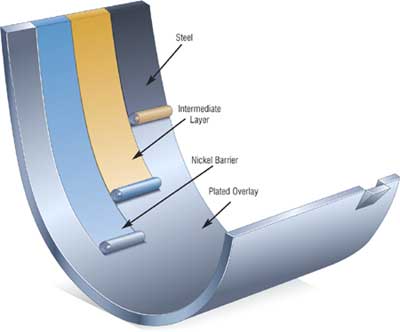is an
alloy used to
provide the bearing surface in a
plain bearing.
It was invented in 1839 by Isaac Babbitt in Taunton, MA. The term is used
today to describe a series of alloys used as a bearing metal. Babbitt metal
is characterized by its resistance to
galling.
Originally used as a cast in place bulk bearing material, it is now more
commonly used as a thin surface layer in a complex, multi metal structure.
Common compositions for Babbitt alloys:
- 90% tin (Sn) - 10% copper (Cu)
- 89% tin (Sn) - 7% antimony (Sb) - 4% copper (Cu)
- 80% lead (Pb) - 15% antimony (Sb) - 5% tin (Sn)

Babbitt metal is soft and easily damaged, and seems at
first sight an unlikely candidate for a
journal bearing surface, but
this appearance is deceptive. The structure of the alloy is made up of small
hard crystals dispersed in a matrix of softer alloy. As the bearing wears
the harder crystal is exposed, with the matrix eroding somewhat to provide a
path for the lubricant between the high spots that provide the actual
bearing surface.